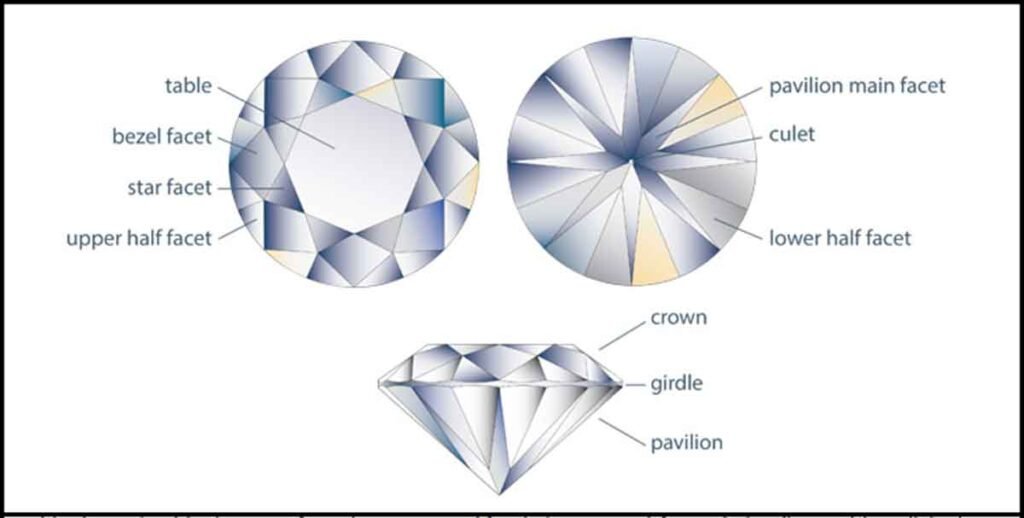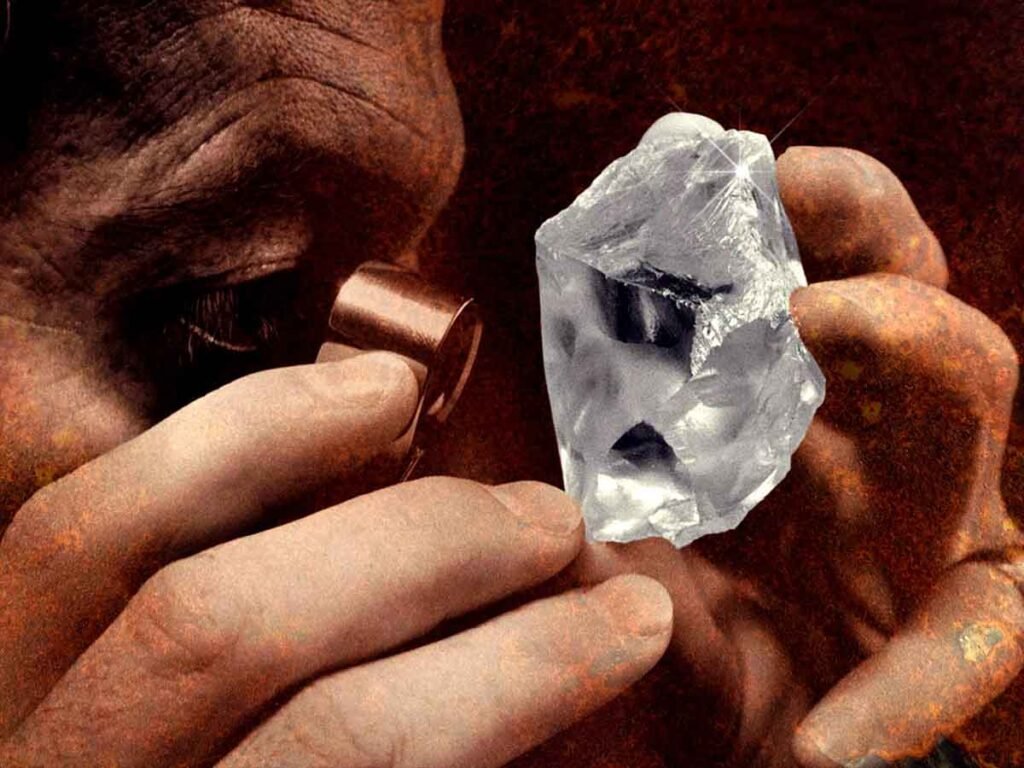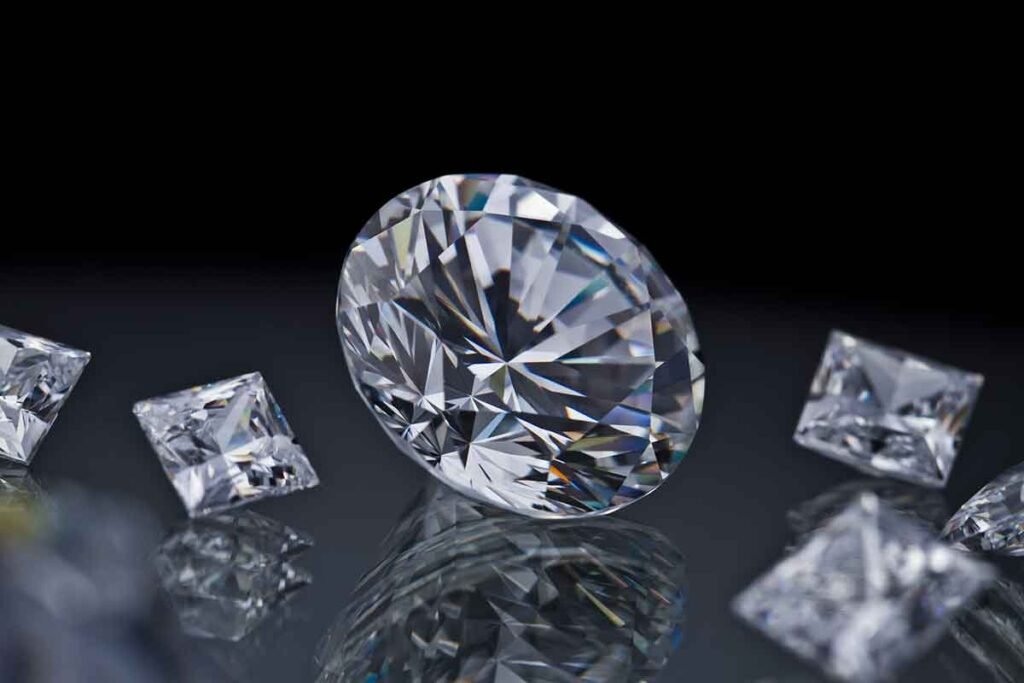The most expensive diamond ever sold was the Pink Star diamond. It was auctioned off at Sotheby’s, Hong Kong, for a whopping $ 71.2 million. For most, that amount is going to create a big hiccup. And raise incredulous questions like, “Why so expensive?'” Or “How are they priced; how are diamonds priced?”
Yes, when buying at auctions, diamonds can be way, way, too expensive. You are not buying just the gem, but the stories behind it. Fortunately, they don’t reflect the real price of diamonds where most people go to buy them—jewelry stores.
But even if you do, you will still be surprised why they are more pricey than other colored stones of similar shape, size, and luster.
If you want to know why this article is for you. It will give you a crash course on how are diamond prices determined, know what questions to ask your jeweler, and what factors resonate with your buying decisions.
And to make your learning easier, below is a nomenclature of a cut gem. It shows the gem parts that count most in determining its price. Know them well. Your knowledge will come a long way to know if you got a better deal or have been ripped off.

Having dispensed with that, let’s get on with the meat of this article.
How Are Diamonds Priced
Consider the price of a diamond being made up of two parts: downstream and upstream. You are now in the downstream part.
The downstream part on how diamonds are priced starts with the 4Cs—a set of standards established by the Gemological Institute of America (GIA). These standards describe a diamond’s visual attributes and help in differentiating one stone from another. This is an indispensable guide in choosing a gem that is well within your budget.
Here they are:
Carat
This is a measure of the gem’s weight and its size, as well. It is the most visible of the 4 Cs. And to give you an idea of how heavy it is in conventional terms, a carat weighs 0.2 gms.
And the size of a diamond is its diameter, measured in millimeters. Assuming all things being equal between two gems, the one with more carats is more pricey.
And “how much would a one carat diamond cost?” you may wonder.
At current prices, it hovers between $1,910-$15,650. The huge gap between minimum and maximum is due to factors you will know further down this article.
So if you are interested to know the diamond price per gram, simply divide the above figures by 0. 2 gm.
Always remember, however, that diamond prices increase exponentially. Once it reaches its critical weight, the prices escalate abruptly. So don’t be shocked to see a huge difference between a 0.2ct and 0.3ct gem. The latter figure is considered a critical weight.
To illustrate the point:
- a 0.5 carat diamond price – $ 36
- a 0.05 carat diamond price – $ 1,500
While the lower carat is only 10 times that of the upper, its price is 42 times higher.
Cut
This is not just to slice up a gem to fit into its setting, but to maximize the sparkle, brilliance, fire, and overall visual beauty of the diamond. It is often considered the most important of the 4 Cs and barring the color factor, the biggest determinant of how diamonds are priced.

What makes a diamond sparkle is how it handles light, and this characteristic is achieved by the way the gem is cut. A well-cut diamond is luminous and reflects white and color light back to your eyes. It bounces back all light that enters it. And it will continue to sparkle even with less light coming in.
On the other hand, when a badly-cut diamond gets dirty, it will look dull and expressionless like a piece of glass.
Color
Diamonds come in a variety of colors (refer to GIS’s color chart). Though color is one of the factors that determine how diamonds are priced, they don’t play a bigger role than cut and carat. But exceptions do happen in the case of colored gems with extremely high clarity.
Clarity
This is a measure of inclusions (inside imperfections) and surface defects called blemishes.
Diamond clarity is determined by a gemologist and is made the basis for grading a diamond against an established scale. The lower a diamond in the grading scale, the lesser the price.
Though clarity is the third most important among the 4Cs in evaluating a diamond, this may not be a primordial concern to an ordinary buyer because these imperfections are too small for the naked eye to see. So if your budget is rather tight, a low-clarity diamond will just be as good.
Is that it? Are the 4Cs the sole determinant of diamond prices? Not quite. There are other details that could add or take a few bucks off from your diamond purchase. Here they are:
Fluorescence
This is the way diamonds react with UV light. It is often a controversial factor in determining diamond prices because some buyers consider it as a defect. What they don’t know is that 30% of diamonds exhibit this quality—a bluish hue—when exposed to UV light.

Fortunately, in most cases, buyers prefer diamonds that fluoresce.
Shape
This is not to be mistaken for the diamond cut. Cut refers to the way it reflects light, while the shape is, well, its geometric shape.
The most common shapes are princess (square), emerald (rectangular), marquise (football-shaped), and oblong.
Symmetry
Refers to size, shaping, and arrangement of the stone’s facets (sides). High symmetry adds value to a diamond and significantly increases its price. A brilliantly-cut diamond normally has 58 facets and a culet.
Polish
This price factor goes back to the manufacturing process. It comes after cutting and faceting. A well-polished diamond will reveal its shine and smooth finish. On the other hand, a poorly finished gem will not allow light to penetrate it, thus affecting its sparkle and brilliance.
Girdle
This is the part that separates the pavilion and the crown. Girdles range between too thin and too thick. Either way, it can affect the diamond’s light reflection.
On top of that, a diamond with a very thin girdle is prone to chipping, while a thick one can make it look smaller than it is.
Culet
The culet (pronounced kyoo-lit) is the pointed bottom of the gem. This is determined by the angles of the pavilion. Zero to a very minimal culet is preferred to prevent light from escaping the diamond; maintain its brilliance.
Certification
When shopping for diamonds, don’t fall into the “impulse-buying” trap. Be very careful and thoroughly evaluate your reasons for buying and your budget. And when you get to the point of adding a diamond item “to cart” ask for a certification.
Though visually, a certified and uncertified diamond may look the same and be just as good. But an expensive buy like that should not be made based on the visual senses alone.
A certificate is an assurance that you are getting a real deal—especially when buying an emotionally laden jewelry item like a diamond engagement ring.
Some dealers shun certification because it adds up to the cost of an item. Keep away from them. You’ll never know what else they are avoiding.
Certification is done by independent gemological laboratories like the GIA, AGS, HRD, etc. Of course, it costs money, hence affects the price of an item.
Pricing
The 4Cs and the items mentioned above determine how diamonds are priced. There was a time when diamonds were arbitrarily priced; when knowledge was space and gemological laboratories were non-existent. Now that they are properly classified, the prices have become within reach for everybody. Now you can buy the gem of your choice and still not feel impoverished.
Of course, the above hasn’t brought down the prices of diamonds. And they never will. So the question that hangs in the air is…
What Makes a Diamond More Expensive?
This brings you to the upstream part of how diamonds are priced. This part will bring us back to the beginning of this interesting diamond price story.

But first, the question: are they really more expensive? You will get a better idea by comparing a diamond with one of the nearest diamond alternatives—the Moissanite.
So how much is a .25 carat diamond worth against Moissanite of the same carat?
At current prices, a diamond costs an average of $ 2,198/carat. On the other hand, the cost of Moissanite is practically half of that.
To bring you up to speed, moissanite comes in second to diamonds in hardness. And it is rarer than diamonds. Yet, why is it cheaper?
Here’s the story…
The De Beers Monopoly
A Rolex watch is more expensive than the others not because it is super-accurate in time-keeping. It’s because of its name. It has established a record, and reputation, of accuracy and elegance.
So do diamonds. They have established, through centuries, of being a symbol of power, wealth, and status. But are they enough reasons for diamonds to be more expensive than the other gemstones? Partly. But this in no way means that gemstones do not deserve a seat at the jewelry table. Want to know more about how to purchase these “other stones”? Check out author Kim Rix’s new book “Gemstone Detective: Buying Gemstones & Jewellery Worldwide.” It truly is worth reading.
Anyway, where were we? Oh yes, back to the question—The real reason for the diamond being more expensive is business.
Since ancient times, diamonds have been much sought-after stones. But they were rare, then. Hence already expensive.
Then in the 1800s, a trove of diamonds was found in Kimberly, South Africa. The find was so huge that it could have flooded the market, driving diamond prices down.
To avoid that, top diamond producer De Beers quickly bought the mine and maintained tight control over the global diamond supply. The company produced just enough diamonds to meet annual demand. This move created the impression that the stone was in limited supply, increasing the prices even more.
Corollary to that, De Beers started an aggressive campaign to promote diamond engagement rings. What was once the turf of rubies and sapphires, diamonds became the gem of choice for engagement rings.
From its inception in 1888 until the start of the 21st century, De Beers controlled 80-85% of the rough diamond distribution.
The landscape has changed since then. More players have come in. Though De Beers has been dislodged from the top spot, it is still one of the top five major players. Here they are:
ALROSA – 38.5 million carats/year
Is a Russian company that operates in the Yakuta Region of Siberia. Today, it accounts for 25% of the world’s diamonds in circulation. Other than this, it also owns a 32% share of Angola’s Catoca Mine.
The main reason for its gaining the top spot is because of its Verkhne-Munskoye mines, which are estimated to hold $4 billion worth of rough diamonds.
De Beers – 30.78 million carats/year
The oldest in the business, De Beers has been mining diamonds since 1888. Founded by British politician and businessman, Cecil Rhodes, in Africa, its majority shares are now held by Anglo-Americans since 2012.
Debswana Diamond – 23.3 million carats/year
This is a 50-50 joint venture between Botswana and De Beers. With no private mining firms allowed to operate in the country, Debswana is the technical loophole to that.
While Botswana does the mining, cleaning, and sorting of the gems, De Beers distributes them.
Rio Tinto Diamonds – 17.03 million carats/year
Rio Tinto was once famous for making the best pink diamonds.

This London-based company has offices in five different countries and operates three diamond mines. It also has partnership agreements with other smaller outfits.
Dominion Diamond – 6.7 million carats/year
This company started in 1994 as Aber Diamond Corporation. After countless evolutions, it is now the Dominion Diamond—a Canada-based mining firm.
Dominion mostly mines diamonds from Diavik: Canada’s largest mine and Ekati diamond mines, both facilities located near de Gras, Canada.
If you are wondering why diamonds are expensive, get a load of this: In 2019, the total rough diamonds sold was $13.9 billion. After polishing, that amount almost doubled to $26.7 billion. And that is not showing the cutting and finishing costs yet.
Last year, blue diamonds like the one in this Finks review, topped the list among the top-selling gems in the world, While it may not speak of the entire diamond color spectrum, it speaks volumes of its drawing power as a jewelry item. In the words of Nick Oppenheimer, “Diamonds are intrinsically worthless, except for the deep psychological need they fill.”
Regardless of how diamonds are price, as long as they fill a need, people will buy them.
Now, if you’re the type who wants color in your stone, check out our article “A Punch Of Color: How The Top Orange Stones Make Your OOTD Pop.”
